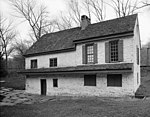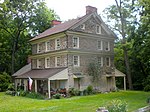Blue Bell Park
Germantown, PhiladelphiaMunicipal parks in PhiladelphiaSchuylkill River
Blue Bell Hill Park commonly known as Blue Bell Park is a small park located in Blue Bell Hill by Germantown, Philadelphia. The park is located on the Wissahickon Creek and is directly southeast of Wissahickon Valley Park. The RittenhouseTown Historic District is located at Blue Bell Hill.In 1974, a small group of undergraduate Pan-Hellenic Council members known as "The Family" founded the Philadelphia Greek Picnic in Blue Bell Park which later attracted an attendance of over 250,000 people.
Excerpt from the Wikipedia article Blue Bell Park (License: CC BY-SA 3.0, Authors).Blue Bell Park
West Walnut Lane, Philadelphia
Geographical coordinates (GPS) Address Nearby Places Show on map
Geographical coordinates (GPS)
| Latitude | Longitude |
|---|---|
| N 40.03307 ° | E -75.196913 ° |
Address
West Walnut Lane
West Walnut Lane
19119 Philadelphia
Pennsylvania, United States
Open on Google Maps








